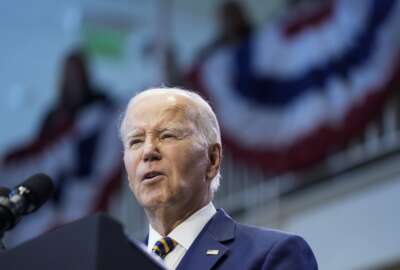Space Force to create new digital modeling strategy
The draft strategy is one way Space Force is working to develop standards for digital twins. It is also working on an open standard. Lisa Costa, the Space Force’s...
Editor’s note: This article has been updated to clarify the Space Force’s digital modeling strategy is still in draft form.
The Space Force is working on a new digital modeling strategy, the latest effort by the service to improve how it uses technology and work towards becoming more digital.
The Space Force is leveraging technologies like artificial intelligence and machine learning to help its Guardians work smarter and more efficiently. This upcoming digital modeling strategy is one piece of the service’s efforts to improve how it uses technology. Lisa Costa, the Space Force’s chief technology and innovation officer, said that the Space Force is working with others to develop standards and is also working on standards for digital twins.
“You would think with the use of digital twins by very large sectors of different industries that there would be commercial standards out there, but there’s not,” Costa said on Wednesday at an event at The Mitchell Institute for Aerospace Studies. “They’re very bespoke, so we’re working toward at least an open standard where we can start to move models from concept. For example, from the Space Warfighter Analysis Center (SWAC), which does mission design, moving that over to our acquisition elements that do costing and analyses of alternatives and then moving that into our operational environment.”
This would help get feedback which could then be tweaked and put into the pipeline for training and testing.
The Space Force sees itself as the first digital service. To accomplish this vision, several things need to happen. Costa said the service is working on removing the tech debt it inherited from the Air Force and other military services and on modernizing its capabilities. She said that it is hard to build advanced technology like AI modeling or digital twins with old architecture. As a result, the foundation must be fixed, Guardians should be upskilled and the Space Force should utilize its Supra Coders, according to Costa.
“Supra Coders are critically important to the Space Force,” Costa said. “They are not just coders; I can buy coders. They are Guardians first, they have been trained usually in at least one operational area and they’re an expert in the operational area, but many of them have been cross trained in a number of different operational areas.”
Supra Coders are self-selected and go through several months of training and internships.
“Supra Coders are experts in space, they are experts in space operations and they are able to put hands on and make changes with other operators in a multidisciplinary team and make changes in real time and that’s really the critical differentiator for Supra Coders,” she said. “So, making a digital service is all about being fast. And having an organizational structure that allows innovation at the edge, bring that innovation into the enterprise, and then push out more capability to do that.”
The Space Force is utilizing a combination of bespoke and commercial technology. According to Costa, it is not changing the base code for its bespoke systems, but it can change and tweak the low-cost commercial systems and have them work with the bespoke systems.
“We are focused on ensuring that the right changes can be made in the right time to get actionable effects to the joint services,” Costa said.
The service is using modern, commercial coding languages and processes. For example, it has DevSecOps and a continuous improvement continuous delivery pipeline. Costa said that this enables the Space Force to bring in commercially trained talent.
“They just bring that capability right into the service, but then train our people in commercial ways,” she said. “So if they do leave the service, if they’re in military uniform, their skills transfer automatically. So I think this is really a great approach for us because it fundamentally reduces cost. We don’t have a bespoke software factory where we’re using some code base or agile process that others are not using.”
Another important element is recruitment. The Space Force is using models and simulation to help see what the force needs to look like in 20 years. She said as the service develops new systems and is developing the models, it also needs to look at the force structure needed to operate it. Furthermore, Space Force invests in its personnel and wants to keep them attached to the mission.
“Contributing to the mission is always a really important part of retention in the military,” Costa said. “I am not too worried about Guardians who will go into industry because they will then know what the Space Force needs and they will be able to develop products at the end of the day that we will be able to buy and that will satisfy our needs better.”
Data is critical to the Space Force. The Unified Data Library, which is where everything is in space and it has different classification levels. The service recently created 176 new requirements for its enhanced unified data library. Costa said it will use AI to cleanse data and she wants Guardians to be able to put data into the library themselves instead of having to go through a contractor. Costa also wants to reduce system backlogs.
“Those requirements are very focused on how you bring in data, process that data and then determine what information is required by an individual organization and what we need to send on that comms pipe,” Costa said.
Costa said that the goal is to make data discoverable at the most tactical edge and to not inundate Guardians and commanders with too much data.
The Space Force also wants to use data and AI for satellites, but there are several things it must consider. For example, when should satellites automatically detect threats? And when should an operator be involved, and how involved should they be? However, there are several associated risks. Specifically, having a satellite maneuver based on what it perceives as a threat when in reality it was not a threat. Officials also need to consider how other nations are using technology.
“China is developing capabilities to determine in real time using AI whether something is a threat or not a threat to a satellite,” Costa said. “But it could be your own satellite, and so that’s a risk as well.”
Lastly, orbital debris, or space junk, is also a problem.
“You want to make sure that you’re not creating debris, and that’s absolutely critical for ensuring that space is usable for everyone” she said.
However, one way to mitigate some of these risks is to have a human in the loop, according to Costa. She said another way is to rank AIs based on the data its been trained on and how long its been trained and used to determine the trust level for the AI and how to leverage it.
She also pointed to the responsible use of AI as an important priority.
“The real key is who will implement reliable, secure and trustworthy AI,” Costa said. “We do have a program and there was an executive order that was put out last Monday articulating the need for responsible AI across the United States. So, we have a number of teams working in responsible AI areas. The key will be to understand when those limits are off, what could potentially happen and how our adversaries might use that.”
Copyright © 2025 Federal News Network. All rights reserved. This website is not intended for users located within the European Economic Area.
Kirsten Errick covers the Defense Department for Federal News Network. She previously reported on federal technology for Nextgov on topics ranging from space to the federal tech workforce. She has a Master’s in Journalism from Georgetown University and a B.A. in Communication from Villanova University.
Follow @kerrickWFED






